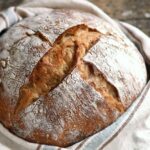Rustic French Sourdough Bread
Traditional Pain de Campagne is rustic French sourdough bread. It starts with an active sourdough starter and follows traditional folding techniques for a perfect loaf every time. Try adding in a few extra ingredients like chopped garlic or kalamata olives. See the section above for details on how to add extra ingredients.
- Prep Time: 2 hours
- Cook Time: 50 minutes
- Total Time: 2 hours 50 minutes
- Yield: 2-3 loaves 1x
- Category: Bread
- Method: Sourdough
- Cuisine: French
- Diet: Vegan
Ingredients
Units
Scale
- 22 oz warm water (2 3/4 cups, 650 ml)
- 26 oz strong white flour (about 5 3/4 cups, 737 g)
- 2 oz whole-grain flour (1/2 cup wheat or rye, 57 g)
- 1/4 oz amaranth (1 tbsp, 7 g – optional for authenticity)
- 12 oz sourdough starter (about 1 1/3 cup, 340 g)
- 1 Tbsp salt
Instructions
- This recipe doesn’t scale perfectly. If you’re planning on making a double batch, expect it to need a bit more flour.
- Warm the water to approximately 33 C / 93 F), and mix it with the flour. Leave the flour to hydrate for 15-30 minutes.
- Once the flour has hydrated, mix in the sourdough starter and salt. See my post on sourdough bread techniques for detailed instructions on how to add in ingredients, fold the dough and form a loaf.
- Allow to rise in a warm location until doubled in volume (about 6-12 hours depending on temperature). Use the dough folding procedure 3-4 times during this rise.
- Place the dough on a well-floured surface and cut into 2 equal pieces. Gently pull and shape the dough into a ball, using flour as needed. Avoid kneading as you don’t want to break the delicate bubbles.
- Place the dough balls in floured baskets (or bowls lined with floured tea towels) and allow them to rise one last time for 2 hours (or overnight in the refrigerator with a lid -see notes for details).
- Preheat to 500 F (250 C). Gently place the loaves in the baking dishes (see notes for options). Score the top of the loaf with a sharp knife.
- Bake for 30 to 50 minutes until brown. The exact timing will depend on whether your oven can get to 500F (mine can’t!). It also depends on whether you’re baking in a Dutch oven, loaf pan, or baking sheet.
- The loaf is done when the outside is nicely browned and the loaf sounds hollow when tapped. Cool on a rack before slicing.
Notes
- This bread recipe requires an active sourdough starter. Depending on the virility of your starter, you may want to add 1/2 tsp of commercial bread yeast. It is traditional for French loaves to contain a mixture of commercial yeast and starter. Just reduce the initial rising time to 4-5 hours if you use commercial yeast.
- Doing a final rise in the fridge is not only convenient, but it helps to develop the sour flavor. The cooler temperature slows down the yeast, allowing the bacteria to work on the flour. To rise in the fridge line a bowl or banneton in a flour-dusted tea towel. Then cap it with a plate. Bake the bread directly from the fridge (there’s no need to warm up the dough).
- Depending on the shape that you want, you can bake this bread in a loaf tin
or a baguette pan. Use a pizza stone
for a flatter loaf or dinner rolls. If we’re baking baguettes or sandwich loaves, we rise the bread directly in the tin.
- We like using a cast iron Dutch oven to make a traditional boule. For the best rise and even browning, place the iron Dutch oven in the oven to preheat. Then bake the loaf in the already hot Dutch oven for 30 minutes with the lid on, then cook uncovered until it has browned (about 20 minutes).
- We have played around with increasing the amount of whole wheat flour in this recipe. It works with up to about 3 cups of whole wheat flour. For a whole-grain loaf, I recommend using my husband’s whole-grain sourdough bread recipe instead.
Nutrition
- Serving Size: 2 slices
- Calories: 147
- Sugar: 0.1g
- Sodium: 351 mg
- Fat: 0.4g
- Saturated Fat: 0.1g
- Carbohydrates: 30.7g
- Fiber: 1.1g
- Protein: 4.2g
Find it online: https://www.fermentingforfoodies.com/french-sourdough-bread/
